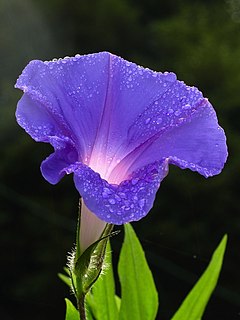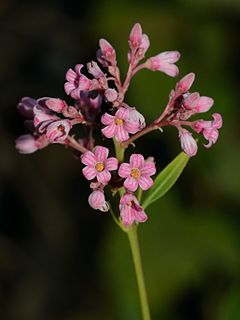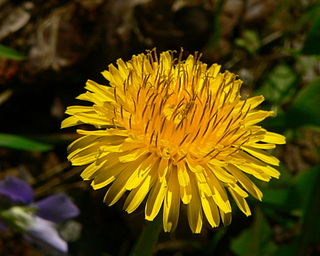Rubber plant is a common name for several plants and may refer to:
- Para rubber tree, a major commercial source of natural rubber
- Castilla elastica , a source of rubber for the ancient Maya people
- Ficus elastica , common ornamental plant
Rubber plant is a common name for several plants and may refer to:

Rubber, also called India rubber, latex, Amazonian rubber, caucho, or caoutchouc, as initially produced, consists of polymers of the organic compound isoprene, with minor impurities of other organic compounds. Thailand, Malaysia, and Indonesia are three of the leading rubber producers.

Morning glory is the common name for over 1,000 species of flowering plants in the family Convolvulaceae, whose current taxonomy and systematics are in flux. Morning glory species belong to many genera, some of which are:

Ipomoea is the largest genus in the flowering plant family Convolvulaceae, with over 600 species. It is a large and diverse group, with common names including morning glory, water convolvulus or kangkung, sweet potato, bindweed, moonflower, etc.

Hevea brasiliensis, the Pará rubber tree, sharinga tree, seringueira, or most commonly, rubber tree or rubber plant, is a flowering plant belonging to the spurge family Euphorbiaceae. It is the most economically important member of the genus Hevea because the milky latex extracted from the tree is the primary source of natural rubber.

Ficus elastica, the rubber fig, rubber bush, rubber tree, rubber plant, or Indian rubber bush, Indian rubber tree, is a species of flowering plant in the family Moraceae, native to eastern parts of South and Southeast Asia. It has become naturalized in Sri Lanka, the West Indies, and the US state of Florida.

Ipomoea alba, sometimes called the tropical white morning-glory or moonflower or moon vine, is a species of night-blooming morning glory, native to tropical and subtropical regions of North and South America, from Argentina to northern Mexico, Florida and the West Indies. Though formerly classified as genus Calonyction, species aculeatum, it is now properly assigned to genus Ipomoea, subgenus Quamoclit, section Calonyction.
Annie may refer to:
Palo amarillo is a common name of Spanish origin for several plants and may refer to:

Rabbitbrush is a common name for shrubs, principally of the western United States, in three related genera of the family Asteraceae:

Apocynoideae is a subfamily of the flowering plant family Apocynaceae. It contains about 78 genera with roughly 860 species. Several genera are of pharmacological interest - notably those - such as Strophanthus - which have furnished highly effective arrow poisons, due to their cardiac glycoside content. The subfamily includes many species with flowers of considerable ornamental value, the best-known of which is Nerium oleander, the familiar Oleander. It also contains the remarkable pachycaul genera Adenium and Pachypodium.

Castilla is a genus of 3 species of large trees in the flowering plant family Moraceae. The genus is native to Central and South America.

Castilla elastica, the Panama rubber tree, is a tree native to the tropical areas of Mexico, Central America, and northern South America. It was the principal source of latex among the Mesoamerican peoples in pre-Columbian times. The latex gathered from Castilla elastica was converted into usable rubber by mixing the latex with the juice of the morning glory species Ipomoea alba which, conveniently, is typically found in the wild as a vine climbing Castilla elastica. The rubber produced by this method found several uses, including most notably, the manufacture of balls for the Mesoamerican ballgame ōllamaliztli.

Funtumia elastica is a medium-sized African rubber tree with glossy leaves, milky sap, and long woody seedpods. The bark is used in the traditional medicine of tropical Africa. It is economically important in West African countries such as Ghana, where it is commonly known as the ofruntum.

Latex is a stable dispersion (emulsion) of polymer microparticles in water. Latexes are found in nature, but synthetic latexes are common as well.

Taraxacum is a large genus of flowering plants in the family Asteraceae, which consists of species commonly known as dandelions. The scientific and hobby study of the genus is known as taraxacology. The genus is native to Eurasia and North America, but the two most commonplace species worldwide, T. officinale and T. erythrospermum, were introduced into North America from Europe and now propagate as wildflowers. Both species are edible in their entirety. The common name dandelion is also given to specific members of the genus.

The balete tree are several species of the trees in the Philippines from the genus Ficus that are broadly referred to as balete in the local language. A number of these are known as strangler figs wherein they start upon other trees, later entrapping them entirely and finally killing the host tree. Also called hemiepiphytes, initially, they start as epiphytes or air plants and grow several hanging roots that eventually touch the ground and from then on, encircling and suffocating the host tree. Some of the baletes produce an inferior quality of rubber. The India rubber plant, F. elastica were earlier cultivated to some extent for rubber. Some of the species like tangisang-bayawak or Ficus variegata are large and could probably be utilized for match woods. The woods of species of Ficus are soft, light, and of inferior quality, and the trees usually have ill-formed, short boles.

Henarathgoda Botanical Garden is one of the six botanical gardens in Sri Lanka. The botanical garden is situated on the Gampaha-Minuwangoda main road, approximately 450 m (1,480 ft) away from Gampaha railway station. It is about 29 km (18 mi) from Sri Lanka's commercial capital of Colombo.

A living root bridge is a type of simple suspension bridge formed of living plant roots by tree shaping. They are common in the southern part of the Northeast Indian state of Meghalaya. They are handmade from the aerial roots of rubber fig trees by the Khasi and Jaintia peoples of the mountainous terrain along the southern part of the Shillong Plateau. Most of the bridges grow on steep slopes of subtropical moist broadleaf forest between 50 and 1,150 m above sea level.
Ficus consociata is a banyan fig species in the family Moraceae. No subspecies are listed in the Catalogue of Life. The species can be found in Indo-China and western Malesia. In Vietnam it may be called đa đồng hành.
Baubotanik is a term that describes a building method in which architectural structures are created through the interaction of technical joints and plant growth. The term entails the practice of designing and building living structures using living plants. In this regard, living and non-living elements are intertwined in such a way that they grow together into plant-technical composite structures.